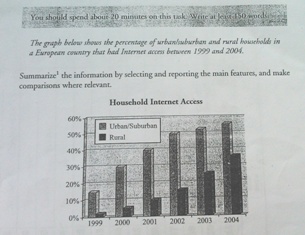The bar chart shows the percentage of city and village household in European country who has internet access between 1999 and 2004. Overall, it can be seen that the propoortion of household internet acces in both areas increased significantly over 5 years.
With regard to the proportion of household internet access in the first 3 years, in 1999 both rural and urban or suburban had just under one in ten. However, in the following year it saw a dramatic rise in the proportion of household internet access in urban area at 30%, while it was only approximately 5% in rural area. Next, in 2001, those proportion increased slightly by 10% for city household and by 5% for village household.
Turning to the percentage of household internet access from 2001 to 2004, while the proportion in rural area rose markedly by 15% from 2001 to 2002, the percentage of household internet acces in urban household increased by approximately 12%. After one year, the proportion of household internet access in both urban or suburban and rural household rose gradually and ended at around 55% and 35%, respectively.
With regard to the proportion of household internet access in the first 3 years, in 1999 both rural and urban or suburban had just under one in ten. However, in the following year it saw a dramatic rise in the proportion of household internet access in urban area at 30%, while it was only approximately 5% in rural area. Next, in 2001, those proportion increased slightly by 10% for city household and by 5% for village household.
Turning to the percentage of household internet access from 2001 to 2004, while the proportion in rural area rose markedly by 15% from 2001 to 2002, the percentage of household internet acces in urban household increased by approximately 12%. After one year, the proportion of household internet access in both urban or suburban and rural household rose gradually and ended at around 55% and 35%, respectively.

DSC_0041.jpg
